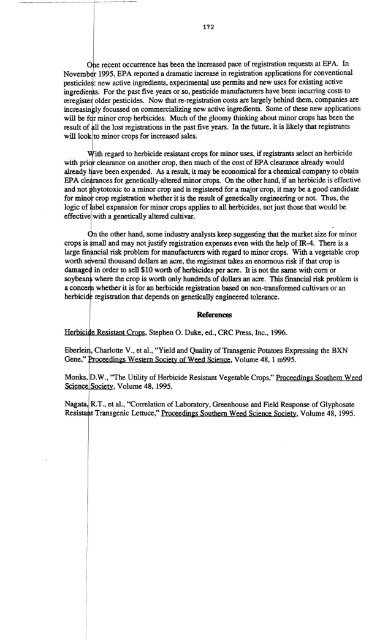Vol. 51â1997 - NorthEastern Weed Science Society
Vol. 51â1997 - NorthEastern Weed Science Society
Vol. 51â1997 - NorthEastern Weed Science Society
You also want an ePaper? Increase the reach of your titles
YUMPU automatically turns print PDFs into web optimized ePapers that Google loves.
172<br />
e recent occurrence has been the increased pace of registrationrequests at EPA. In<br />
Novemb 1995,EPA reported a dramatic increase in registrationapplicationsfor conventional<br />
pesticide : new active ingredients,experimentaluse permits and new uses for existing active<br />
ingredie . For the past five years or so, pesticide manufacturershave been incurring costs to<br />
reregiste older pesticides. Now that re-registrationcosts are largelybehind them, companies are<br />
increasin ly focussed on commercializingnew activeingredients. Someof these new applications<br />
will be f r minor crop herbicides. Much of the gloomythinkingabout minor crops has been the<br />
result of the lost registrationsin the past five years. In the future,it is likely that registrants<br />
wi11100kto minor crops for increased sales.<br />
ith regard to herbicideresistant crops for minor uses, if registrantsselect an herbicide<br />
with pri clearance on another crop, then much of the cost of EPA clearance already would<br />
already ave been expended. As a result, it may be economicalfor a chemical company to obtain<br />
EPA de ces for genetically-alteredminor crops. On the otherhand, if an herbicideis effective<br />
and not hytotoxic to a minor crop and is registered for a major crop, it may be a good candidate<br />
for mino crop registration whether it is the result of geneticallyengineering or not. Thus, the<br />
logic of abel expansion for minor crops applies to all herbicides,notjust those that would be<br />
effective with a genetically altered cultivar.<br />
the other hand, some industry analysts keep suggestingthat the market size for minor<br />
crops is mall and may not justify registrationexpenseseven with the help of IR-4. There is a<br />
large fin cial risk problem for manufacturerswith regard to minorcrops. With a vegetable crop<br />
worth s eral thousand dollars an acre, the registrant takes an enormousrisk if that crop is<br />
damage in order to sell $10 worth of herbicides per acre. It is not the same with corn or<br />
soybean where the crop is worth only hundreds of dollars an acre. Thisfinancial risk problem is<br />
a conce whether it is for an herbicideregistrationbased on non-transformedcultivars or an<br />
herbici registration that depends on geneticallyengineeredtolerance.<br />
References<br />
=~~~_~~~" Stephen O. Duke, ed., CRC Press, Inc., 1996.<br />
Nagata, RT., et al., "Correlation of Laboratory,Greenhouse and Field Response of Glyphosate<br />
Resis t Transgenic Lettuce:' ProceedingsSouthern<strong>Weed</strong> <strong>Science</strong><strong>Society</strong>, <strong>Vol</strong>ume 48, 1995.
















